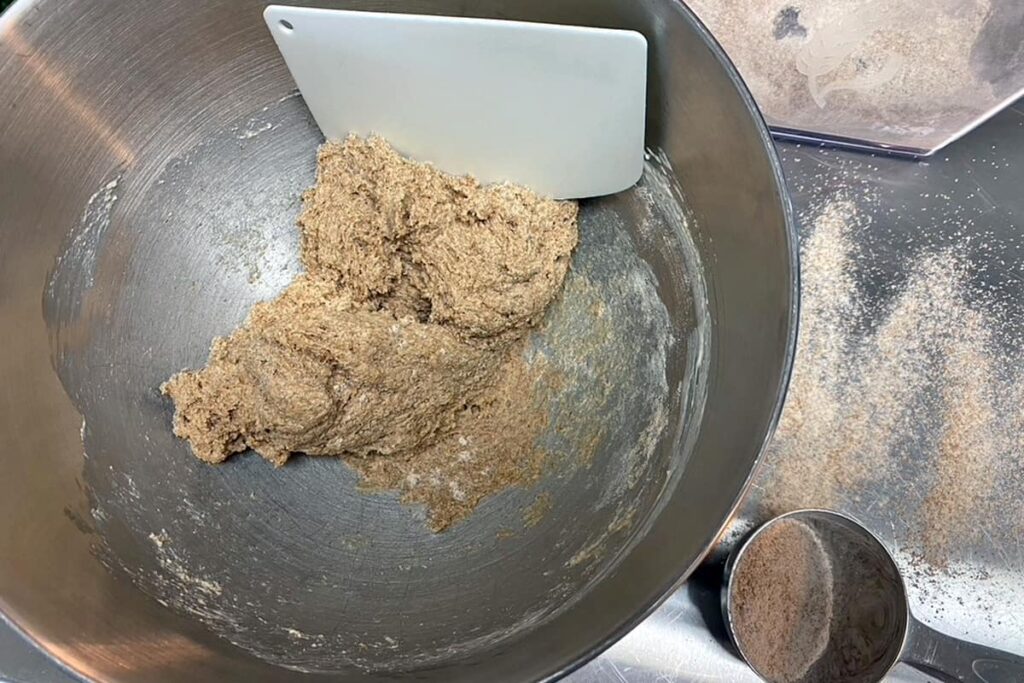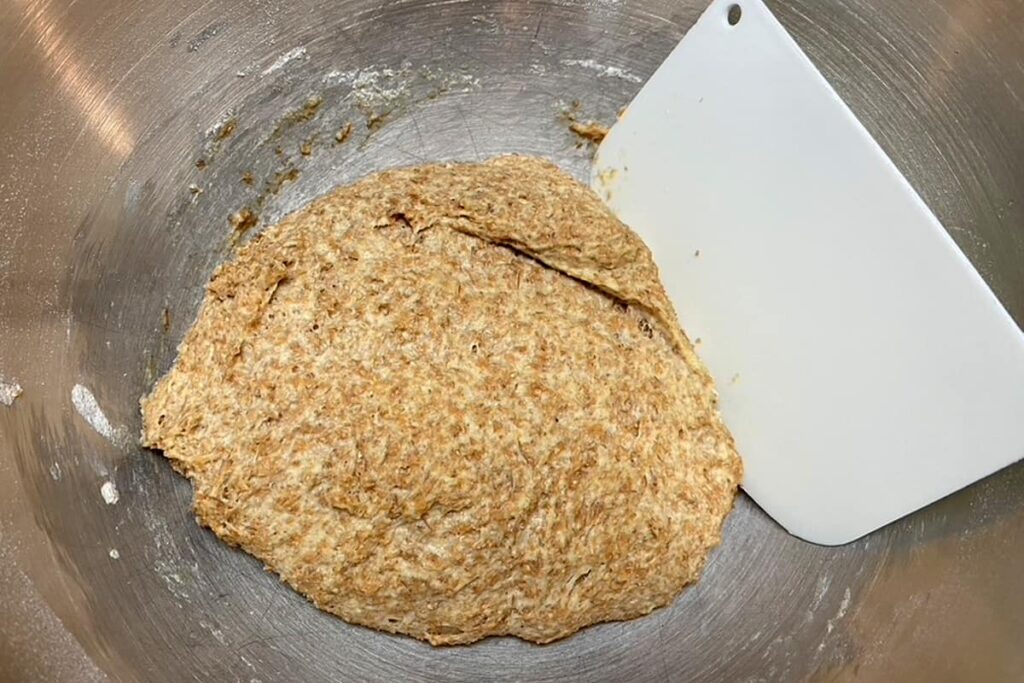As a home baker, I’ve tried my hand at making various types of bread, and one question that often pops up is whether or not a bowl scraper is necessary. A bowl scraper can be a valuable tool, especially when working with stickier doughs like Einkorn, but is it an essential part of bread-making?
Einkorn flour is an ancient grain with a unique set of properties that make it a healthy and delicious choice for bread-making. However, one of its trademark characteristics is the sticky nature of its dough, a quality that takes some getting used to (I have had some hilariously-awful failures with the stickiness of Einkorn!). This is where a bowl scraper can come in handy as it makes handling and shaping the dough so much easier.
In my bread-making journey, I’ve found that a bowl scraper can significantly improve the overall process by preventing dough from sticking to the sides of the bowl or my hands, making it easier to manage. So, while you might not consider it an absolute essential, investing in a bowl scraper can definitely enhance your bread-making experience, especially if you are using flour from ancient grains such as Einkorn, Kamut, or Spelt.
But if you’re still on the fence, let’s get into some more details about this handy little tool.
Necessity of bowl scrapers
Einkorn and stickier doughs

Einkorn is an ancient grain that has gained popularity in recent years for its unique flavor and nutritional profile. The dough made from Einkorn can be quite sticky and challenging to handle without the right tools.
That’s where the bowl scraper comes in handy. This inexpensive kitchen gadget has been a lifesaver for me, making it easier to get the last of the batter out of the bowl and work with those sticky doughs. I mean, it’s literally just a shaped piece of plastic … but with its flexible edges, it easily conforms to the shape of the mixing bowl, ensuring that no dough goes to waste. Plus, its compact size and shape provide better leverage when handling difficult doughs, making the process more enjoyable overall.
Comparing bowl and bench scrapers
While both the bowl scraper and bench scraper serve a purpose in bread-making, they have distinct differences that make each one useful in its own right. (Don’t be embarrassed if you thought these were the same thing–I thought that too!)
A bowl scraper is specifically designed for removing dough from a mixing bowl and working with sticky doughs, while a bench scraper is meant for cutting and dividing dough on a work surface.
Here’s a quick comparison of the two:
- Bowl scraper: Flexible, curved edges to conform to the shape of a mixing bowl, and ideal for working with sticky doughs like Einkorn, Kamut, or Spelt. Typically made out of a flexible plastic
- Bench scraper: Rigid, straight-edged for cutting and dividing dough on a work surface, and best for manipulating dough that’s already out of the bowl. Typically made out of metal
From my experience, I find that having both types of scrapers in my bread-making toolkit is invaluable. They each play an essential role, and neither one can fully replace the other.
Summary
A bowl scraper is not strictly necessary for bread-making, but it can be very helpful. It’s used for scraping dough out of bowls, cutting and dividing the dough, and helping to shape it without sticking to your hands or the work surface.
It’s especially useful when working with wetter doughs, like many ancient grains, as it helps handle the dough more easily without adding extra flour, which can alter the bread’s texture. If you don’t have a bowl scraper, you can use a sturdy spatula or your hands, but a scraper can make the process more efficient and tidy.
Frequently asked questions
What is a bowl scraper used for in baking?
A bowl scraper is a flexible tool used in baking to efficiently remove dough from mixing bowls. It ensures minimal waste and ease of transferring dough. Additionally, it can be used for folding and shaping dough, particularly useful for sticky doughs, like those made from 100% whole ancient grains, that might otherwise adhere to hands or surfaces.
Can I use a bowl scraper with all types of dough?
Yes, a bowl scraper is versatile and can be used with various types of dough, from wet, sticky bread doughs to firmer pastry doughs. Its flexibility allows it to conform to the shape of the bowl, making it efficient for scraping out doughs of different consistencies.
You can also use it for batters (pancakes or muffins) or even a marinade. It’s helpful to “scrape” out every last bit of whatever is in your bow.
Is a bowl scraper necessary for making bread?
While not essential, a bowl scraper is highly beneficial in bread-making. It aids in handling sticky dough, scraping out bowls, and cutting or shaping the dough. It simplifies the process and helps in maintaining the texture of the dough by avoiding excess flour addition.
If you are starting a whole grain journey, it’s an expensive tool to get. Most ancient grains have less gluten, making them much stickier to work with. A bowl scraper just makes it easier.
How do I clean and maintain a bowl scraper?
Cleaning a bowl scraper is straightforward. I usually soak it to loosen the dough that is left, then throw it into the top rack of my dishwasher.
I will also wash it by hand with regular soap and water.
Are there different types of bowl scrapers?
Yes, bowl scrapers come in various materials, like plastic, silicone, or metal, and in different shapes and sizes. Some have a straight edge, while others are curved. The choice depends on personal preference and the type of baking you do.
Can I substitute something else for a bowl scraper?
If you don’t have a bowl scraper, alternatives like a stiff spatula, a dough cutter, or even a rigid piece of plastic can be used. However, these might not be as effective in conforming to the bowl’s shape or in handling very sticky dough.
Is a plastic or metal bowl scraper better for bread-making?
Plastic bowl scrapers are generally preferred for bread-making due to their flexibility and ability to conform to the shape of mixing bowls. Metal scrapers, while durable, are better suited for cutting and dividing dough on a work surface.
How do I use a bowl scraper effectively when shaping dough?
To use a bowl scraper effectively, hold it comfortably in your hand and use a gentle but firm motion to scrape or fold the dough. When shaping dough, use the scraper to lift and fold the dough over itself, aiding in the development of gluten without sticking to your hands or the surface.
What to do if bread dough is too sticky?
If your bread dough is too sticky, try using dampened hands (either with water or olive oil) and a bench scraper to handle it. This will allow you to work with the dough without adding extra flour, which can make the bread dense.
What are the benefits of using a bowl scraper?
A bowl scraper comes in handy when working with sticky doughs. It allows you to easily scrape stuck dough from the sides of the bowl and fold it back into the main dough mass. It also helps keep your hands clean and prevent excess dough from sticking to them.
Can you make Einkorn bread without a bowl scraper?
Yes, you can make Einkorn bread without a bowl scraper. However, using one will make the process much easier and less messy, especially when dealing with sticky einkorn dough.
If you don’t have a bowl scraper, you can also use a spatula or even your hands. Just wet your hands or the spatula with either water or olive oil first, then use it “scrape” the dough out of the bowl.








